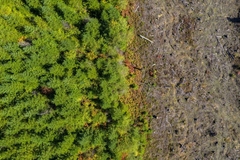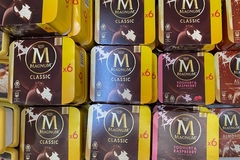
- Industry news
Industry news
- Category news
Category news
- Reports
- Key trends
- Multimedia
- Journal
- Events
- Suppliers
- Home
- Industry news
Industry news
- Category news
Category news
- Reports
- Key trends
- Multimedia
- Events
- Suppliers
Queen of flavors: Vanilla rises above transparency concerns to lead category

03 Sep 2019 --- While vanilla remains one of the most widely used flavors within the food industry, there is still opportunity for growth as it plays into plant-based and sustainability trends. Its multiple facets make it a unique, versatile and highly evocative flavor in line with key trends influencing the industry. Despite this popularity, there are concerns around sourcing and sustainability, as consumers continue to demand transparency. Yet industry experts explain to FoodIngredientsFirst that, nonetheless, it is expected to maintain its classic appeal and strong market positioning.
“Vanilla has always been and always will be the queen of flavors. Its appeal is unique and universal. Many people do not know this, but vanilla is an integral part of the chocolate recipe, rounding and enriching the cocoa profile to deliver the much-loved chocolate taste,” Dominique Delfaud, Marketing, Sensory and Consumer Research Director at Mane, tells FoodIngredientsFirst.

Delfaud also explains that vanilla is “an absolute must” in ice-cream and many other dairy products and baked goods. Vanilla flavoring is used in all categories of sweet recipes, hot beverages, alcoholic beverages and confectionery. It is also increasingly used in savory dishes to season meat and vegetables, she adds.
 “Vanilla will remain one of the most widely used flavoring agents in the food industry. "“Vanilla will remain one of the most widely used flavoring agents in the food industry. Recently, we have also observed developments in the premium quality category. Consumers deserve quality and they are looking for natural, organic and Fairtrade vanilla,” Laurent Bourgois, President at Eurovanille notes.
“Vanilla will remain one of the most widely used flavoring agents in the food industry. "“Vanilla will remain one of the most widely used flavoring agents in the food industry. Recently, we have also observed developments in the premium quality category. Consumers deserve quality and they are looking for natural, organic and Fairtrade vanilla,” Laurent Bourgois, President at Eurovanille notes.
The flavoring’s applications are wide and versatile, allowing for surprising flavor combinations. “There are products that combine vanilla with chocolate, toffee, toasted coconut, and most nuts. Vanilla can also be associated with coffee, honey, and various types of brown notes. The main obstacle to these associations is the subtle and delicate taste of vanilla that can be overwhelmed by some aromas. Thus, in a combination of vanilla and hazelnut, the earthy taste of hazelnut can easily take over. It is a flavorists’ mission to find the right balance between the different ingredients for a successful association,” Kevin Bangratz, Marketing Researcher at Prova, tells FoodIngredientsFirst.
Vanilla is also well-combined with fruity flavors, according to Dr. Daphna Havkin-Frenkel, General Manager of Bakto Flavors. “Vanilla goes very well with fruit flavors and citrus as well. Combinations of vanilla with banana, raspberry, coconut or cherry are popular. As a flavorist, I don’t see any hurdles in flavor combinations with vanilla. Because it’s a mild flavor, you have to be careful not to overwhelm the vanilla and cover it up with stronger ones,” she adds.
 Vanilla’s applications are wide and versatile, allowing for surprising flavor combinations.“Vanilla also has high levels of antioxidant activity, and adding this to food makes it healthier. Adding small amounts of vanilla to many food applications also smooths out the flavor and reduces bitterness, even when the taste is not noticeable. For example, adding a bean of vanilla to spaghetti sauce while cooking reduces the overall sourness,” adds Dr. Havkin-Frenkel.
Vanilla’s applications are wide and versatile, allowing for surprising flavor combinations.“Vanilla also has high levels of antioxidant activity, and adding this to food makes it healthier. Adding small amounts of vanilla to many food applications also smooths out the flavor and reduces bitterness, even when the taste is not noticeable. For example, adding a bean of vanilla to spaghetti sauce while cooking reduces the overall sourness,” adds Dr. Havkin-Frenkel.
What makes vanilla so unique is that it does not clash with any other flavor, notes Delfaud. “A novel combination we have been promoting in recent years is vanilla and tonka. An amazing spice from the Amazon, the tonka bean has a luscious flavor profile whose warm, almond and honey facets blend perfectly with vanilla, creating a totally original and highly indulgent flavor experience.”
Overlapping trends
Vanilla’s multiple facets make it a unique, versatile and highly evocative flavor in line with key trends influencing the industry, Delfaud says. “Vanilla elicits four rich and complex image perceptions in consumers’ minds. It is strongly linked to comfort and authenticity, which is aligned with the naturalness trend deeply influencing our industry. On a different note, vanilla invites consumers on a tropical journey, reminiscent of a soft and warm atmosphere, tapping into the escape trend.”
“Vanilla is also perceived as a beautiful and delicate spice of traceable origin. The traceability of raw materials is a growing trend in our industry and is well illustrated by consumers’ expectations regarding vanilla. Last but not least, vanilla is a dessert favorite and the perfect companion for ice-cream, cakes, pastries and other baked goods, corresponding to the long-lasting indulgence trend in flavors,” she adds.
Vanilla derived only from vanilla beans is mostly organic, explains Bourgois. This may also allow for clean label and naturality claims that are a rising trend among consumers.
There is a growing number of products that refer to the origin of vanilla on their packaging. However, as consumers become better informed, there is a tendency to offer more and more exotic vanilla origins. It is now possible to find products with vanillas from India, Indonesia – Java vanilla is particularly popular – Tahiti or Papua New Guinea, says Marie Le Beller, Product Manager at Prova. “The most common origin is Madagascar. The claim ‘Bourbon vanilla’ also appears frequently. ‘Bourbon’ refers to origin since Bourbon vanilla comes from the Indian Ocean, mainly from Madagascar, the Comoros or Reunion Island.”
Delfaud also notes that as plant-based dairy alternatives such as oat, almond, coconut and soya are rapidly gaining momentum in developed markets, vanilla is by far the preferred flavor for those trendy applications, as well.
How does vanilla rank on sustainability?
Sustainability and the supply chain in vanilla is a serious problem, according to Dr. Havkin-Frenkel. The way the system works, small-scale farmers who have a few plants in their backyard are able to sell the green beans to collectors for low prices, which doesn’t sustain them, she says.
 Sustainable vanilla farming is a challenge in Madagascar due to the climatic, political and social environment.Vanilla comes from a rare orchid native to Central America, whose cultivation spread to the Bourbon Islands in the Indian Ocean in the 19th century. Growing vanilla is extremely complex and labor-intensive explains Delfaud. In 2019, 80 percent of the estimated global production came from Madagascar, one of the poorest countries in the world. Sustainable vanilla farming is a challenge in Madagascar due to the climatic, political and social environment.
Sustainable vanilla farming is a challenge in Madagascar due to the climatic, political and social environment.Vanilla comes from a rare orchid native to Central America, whose cultivation spread to the Bourbon Islands in the Indian Ocean in the 19th century. Growing vanilla is extremely complex and labor-intensive explains Delfaud. In 2019, 80 percent of the estimated global production came from Madagascar, one of the poorest countries in the world. Sustainable vanilla farming is a challenge in Madagascar due to the climatic, political and social environment.
“Based on the understanding that vanilla quality and sustainability are closely interlinked, Mane has continuously established value chains with farmers’ associations to secure the sourcing of vanilla beans from Madagascar for the last 40 years. In 2000, Mane went a step further, founding a local company with a plantation and processing unit. This enabled us to control the cultivation and preparation of beans from flower to mature bean, carry out variety selection, and manage vanilla farming communities on the ground,” she notes.
Being an active player in the vanilla sector comes with responsibility. “In this space, Prova founded in 2012 the NGO Vanille Durable Bemanevika (VDB), situated in Madagascar. Since 2014, Barry Callebaut together IDH joined the initiative for a five-year project, which contributes to the sustainability of the vanilla sector by helping vanilla farmers become more resilient to its instability. Farmers face an economic dependency on vanilla cultivation and food insufficiency is still very common, which is exacerbated by income mismanagement. Barry Callebaut applied its long-standing cocoa expertise in association with Prova’s local vanilla know-how, creating synergies on the ground for the benefit of the communities, ” says Alessandra Ognibene-Lerouvillois, Chief Sustainability Officer at Prova.
“VBD has been supporting over 650 farmers in seven villages, with actions reaching out to over 2,500 direct beneficiaries. Our activities seek to improve farmers’ standards of living by aiming for their complete autonomy through the reinforcing of their technical and financial competencies. Finally, to monitor our actions and measure our impact closely, VDB is audited yearly by EcoCert,” she adds.
Going forward, the industry is exploring how vanillin, a widely used synthetic vanilla flavor, could be produced by natural vanilla sources. “We’ve started growing vanilla in greenhouses in Israel and other locations with the hope that this will solve some of the crisis and will protect the vanilla cultivation from Fusarium, a disease that has been spreading in many places, solely because growers are using infected cuttings,” Dr. Havkin-Frenkel concludes.
By Kristiana Lalou










